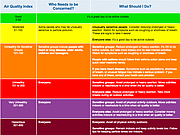Silver Valley smoke out
PINEHURST – For roughly three weeks, the Silver Valley and surrounding region have been plagued by excessive smoke and degraded air quality levels. Wildfires burning across Washington, Oregon and Idaho have all contributed to the haze that has limited outdoor recreation and athletics.
Silver Valley air took its first hit two weeks ago on Aug. 7 when IDEQ downgraded its quality to “Moderate” levels. Since that day, the local air quality has only degraded further; jumping around from being “Unhealthy for Sensitive Groups” to “Very Unhealthy” and even “Hazardous” for a brief time.
These continuous poor ratings led to the Panhandle Health District issuing a wildfire smoke advisory for all of North Idaho on Aug. 13.
During these periods of degraded air quality, it is important that residents follow the guidelines set out by IDEQ that correspond with the current level of quality. These levels are determined by the amount of pollutant detected in the air (In this case, the specific pollutant of concern is Fine Particulate Matter, or PM2.5).
When pollutant levels rise, the Air Quality Index value rises as well. The higher the AQI value, the worse the health level gets.
Since the Silver Valley has been consistently clocking in at a AQI value of 101 or higher, those who fall into the “sensitive group” should reduce prolonged or heavy exertion and watch for symptoms such as couching or shortness of breath. Those with asthma should follow their asthma action plans and keep quick relief medicine handy. People with heart diseases that experience symptoms such as palpitations, shortness of breath, or unusual fatigue may have a serious problem and should contact their health care provider.
If AQI levels reach “Unhealthy” and above, members of these sensitive groups should consider completely avoiding outdoor physical activities and/or going outside altogether.
The general population should also avoid strenuous outdoor activities and/or heavy exertion when AQI levels are “Unhealthy” or “Very Unhealthy.”
In the event of “Hazardous” conditions, everyone should limit their time outside (especially members of sensitive groups, who should not go out at all).
Particle pollution has been linked to a number of health problems including coughing, wheezing, reduced lung function, asthma attacks, heart attacks, strokes, and even death.
The Silver Valley collects its air quality data from the IDEQ air monitoring station in Pinehurst.
All outdoor open burning currently is prohibited in accordance with the Rules for the Control of Air Pollution in Idaho (IDAPA 58.01.01.550).
As long as the regional wildfires continue to burn, air quality will continue to be degraded. PHD and IDEQ will continue to monitor air quality conditions and will issue additional advisories as conditions warrant.
IDEQ and PHD contributed to this article.
To see the live air-quality map, visit http://airquality.deq.idaho.gov.







